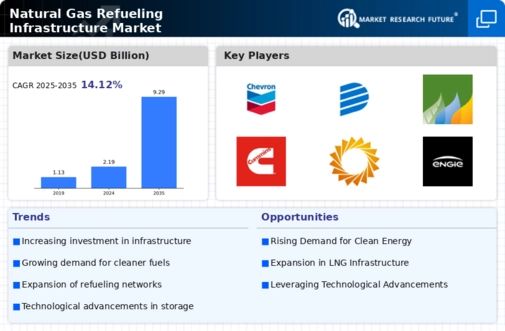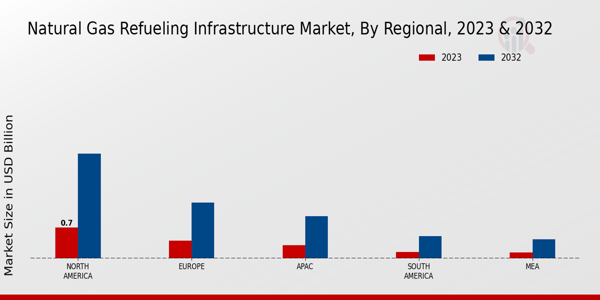Market Growth Projections
The Global Natural Gas Refueling Infrastructure Market Industry is poised for substantial growth, with projections indicating a market value of 2.19 USD Billion in 2024 and an anticipated rise to 9.29 USD Billion by 2035. This growth reflects a compound annual growth rate (CAGR) of 14.04% from 2025 to 2035. Such projections highlight the increasing investment in natural gas refueling infrastructure, driven by factors such as government incentives, technological advancements, and the rising adoption of natural gas vehicles. The market's expansion is indicative of a broader shift towards cleaner energy solutions, positioning natural gas as a key player in the future of transportation.
Growing Demand for Clean Energy
The increasing global emphasis on clean energy solutions drives the Global Natural Gas Refueling Infrastructure Market Industry. As nations strive to reduce greenhouse gas emissions, natural gas emerges as a cleaner alternative to traditional fuels. This shift is evident in various regions, where governments implement policies to promote natural gas vehicles (NGVs). For instance, in 2024, the market is projected to reach 2.19 USD Billion, reflecting the rising adoption of NGVs. The transition to cleaner fuels not only supports environmental goals but also enhances energy security, thereby fostering the expansion of natural gas refueling infrastructure.
Global Energy Transition Initiatives
The ongoing global energy transition initiatives are reshaping the Global Natural Gas Refueling Infrastructure Market Industry. As countries commit to reducing reliance on fossil fuels, natural gas is positioned as a transitional fuel that can bridge the gap towards renewable energy sources. This strategic positioning is supported by international agreements aimed at mitigating climate change. Consequently, investments in natural gas infrastructure are likely to increase, fostering the development of refueling stations worldwide. The market's growth trajectory, projected to reach 9.29 USD Billion by 2035, underscores the importance of natural gas in the broader context of energy transition.
Government Incentives and Regulations
Government initiatives play a crucial role in shaping the Global Natural Gas Refueling Infrastructure Market Industry. Many countries are introducing incentives such as tax breaks, grants, and subsidies to encourage the development of natural gas refueling stations. For example, the U.S. Department of Energy has launched programs aimed at increasing the number of NGV refueling stations across the country. These regulatory frameworks not only facilitate investment in infrastructure but also stimulate consumer interest in natural gas vehicles. As a result, the market is expected to grow significantly, with projections indicating a rise to 9.29 USD Billion by 2035.
Rising Adoption of Natural Gas Vehicles
The increasing adoption of natural gas vehicles (NGVs) significantly influences the Global Natural Gas Refueling Infrastructure Market Industry. As consumers and businesses recognize the economic benefits of NGVs, including lower fuel costs and reduced maintenance expenses, the demand for supporting infrastructure grows. This trend is particularly evident in commercial fleets, where companies seek to optimize operational costs while adhering to environmental standards. The expansion of NGV adoption is expected to drive the establishment of new refueling stations, thereby enhancing the overall market landscape. This growing trend aligns with the projected market value of 2.19 USD Billion in 2024.
Technological Advancements in Refueling Systems
Technological innovations are transforming the Global Natural Gas Refueling Infrastructure Market Industry. Advances in refueling technology, such as fast-fill systems and improved storage solutions, enhance the efficiency and convenience of natural gas refueling. These developments not only reduce downtime for vehicles but also make natural gas a more attractive option for fleet operators. Furthermore, the integration of smart technologies, including real-time monitoring and automated systems, is likely to streamline operations. As these technologies continue to evolve, they may contribute to a more robust infrastructure, supporting the anticipated market growth of 14.04% CAGR from 2025 to 2035.














